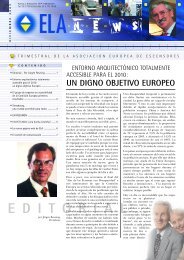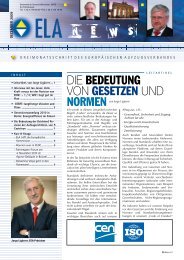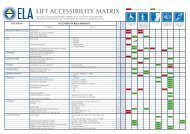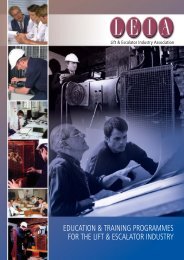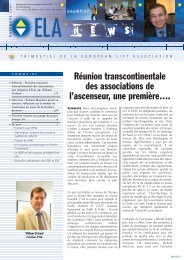WP6-Brochure-E4 brochure - ELA European Lift Association.
WP6-Brochure-E4 brochure - ELA European Lift Association.
WP6-Brochure-E4 brochure - ELA European Lift Association.
You also want an ePaper? Increase the reach of your titles
YUMPU automatically turns print PDFs into web optimized ePapers that Google loves.
24 Switch off other lift components when not in use<br />
Stand‐by consumption can be a main driver of energy consumption; various strategies to<br />
switch off components exist. For shorter periods of non‐usage, only some of the components<br />
may be switched off (“sleep mode”). Putting the lift back into stand‐by operation will require<br />
only a short period of time (some seconds). For longer periods, for example during the night,<br />
more components can be switched off, (“deep‐sleep mode”).<br />
Recommendation: components not in use should be switched off while the lift is not<br />
operating, while ensuring the safe operation of the lift.<br />
Relevance: all installations.<br />
25 Switch off comfort equipment when not required<br />
As pointed out above, it should also be checked whether non‐lift comfort equipment must<br />
necessarily run 24 hours a day or if it can be put into sleep mode as well.<br />
Recommendation: check switching off comfort equipment.<br />
Relevance: all installations.<br />
26 Switch temperature control of machine room according to requirements<br />
Due to energy losses, heat is accumulated in the machine room. To avoid components from<br />
overheating or freezing, machine rooms sometimes need to be climate controlled. The settings<br />
for the temperature control should be adjusted appropriately for the equipment. Too narrow<br />
limits lead to higher energy demand than necessary.<br />
Recommendation: use temperature control in the machine room only when the temperature<br />
levels move outside acceptable limits.<br />
Relevance: all installations.<br />
27 Operate oil heater and cooler only when required<br />
In hydraulic systems, hydraulic fluids are best used in certain temperature intervals (due to<br />
reasons of viscosity and safety of operation). To assure an adequate oil temperature, heating<br />
and cooling devices are used to keep temperature at a steady level.<br />
Recommendation: oil heating and cooling should only be engaged when the oil temperature<br />
leaves the normal operating temperature.<br />
Relevance: relevant both for new and existing installations with oil heaters and coolers.<br />
28 Switch off car roof light/ shaft illumination after service<br />
The shaft and sometimes also the car roof have lighting which is necessary for service and<br />
maintenance work. This lighting should be switched off if not needed.<br />
Recommendation: check if illumination is switched off after service or use an automatic<br />
switch‐off function.<br />
Relevance: all installations.<br />
29 Check correct type and adequacy of lubrication<br />
Adequate lubrication (if required) of the guiding rails should be part of the regular<br />
maintenance programme to avoid unnecessary losses due to friction.<br />
Recommendation: check adequate lubrication where required.<br />
Relevance: all installations where lubrication is required.<br />
113





